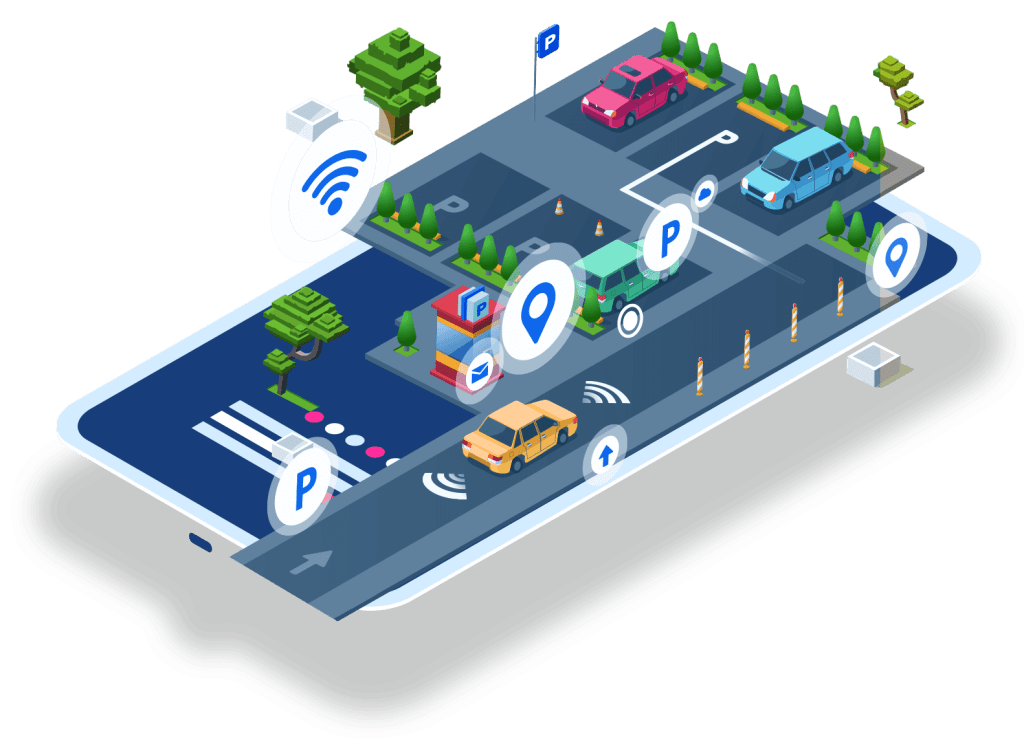Smart parking lots are the most interoperable and effective smart parking platforms with IoT technology in recent times.
Its objective is based on minimizing the levels of traffic congestion in urban and busiest areas.
For years, parking a car, especially in big cities, has become a challenge. Looking for a space on the street is a circumstance that generates significantly high levels of stress among drivers.
Thanks to IoT technology, which arises to make life easier and everyday life easier for users, solutions have been appearing to help drivers park more intelligently.
This type of smart parking technology with IoT works through sensors that are the ones that collect certain information about the state of traffic, roads, available places, or mobility at a given time.
On the other hand, smart car parks also work with Big Data, collecting large data content and thus being able to offer personalized solutions for each user in real-time.
Most EUROPEAN cities have already launched their own smart parking projects. One of the examples is the Madrid Central project, where polluting cars can only access this area if they park in public car parks.
Thus, searching for a parking space becomes a very useful tool for drivers. In fact, Central EUROPE has its own app that indicates in real time the parking spaces available at all times.
3 benefits of smart parking with IoT
1. Driving time is reduced
First of all, one of the main benefits of smart parking is that driving time is reduced, and consequently, stress levels inside the vehicle are reduced.
As a consequence, it is possible to arrive on time at our destination, be it work, study center, or any other place where you have to be on time. In addition to making the most of time.
2. Reduces stress levels
Having a high percentage of safety in the time spent driving considerably reduces stress levels among drivers and makes it possible to make the most of time for other activities.
3. Lower pollution levels
Looking for parking means having the vehicle running and increasing pollution levels. This situation, with smart parking, and being clear where we should park, considerably reduces pollution.
Real-Time Parking Availability Information
In a smart parking system, the first step towards providing real-time parking availability information is the use of sensors and cameras for occupancy detection. These sensors are typically installed in individual parking spaces or at the entrance of parking lots. They can detect whether a parking spot is occupied or vacant by monitoring the presence or absence of a vehicle.
A. Sensors and Cameras for Occupancy Detection
- Sensor Technology: Smart parking systems employ various sensor technologies, including ultrasonic sensors, magnetic sensors, infrared sensors, and pressure sensors. These sensors are capable of accurately detecting the presence or absence of vehicles in real-time. For instance, ultrasonic sensors emit high-frequency sound waves that bounce off objects, and the sensors measure the time it takes for the sound waves to return, determining the presence of a vehicle.
- Camera Technology: Cameras can also be used for occupancy detection in smart parking systems. They capture images of parking spaces and employ image processing techniques, such as computer vision algorithms, to analyze the images and determine whether a space is occupied or available.
B. Transmission of Data to the Central System
Once the occupancy status of parking spaces is determined, the next step is to transmit this data to a central system where it can be processed and made available to drivers in real-time. Several communication technologies are used for this purpose.
- Wireless Communication: The data from the sensors or cameras is wirelessly transmitted to a central server or cloud-based system. This can be achieved using technologies like Wi-Fi, Bluetooth, or cellular networks. The choice of communication technology depends on factors such as the range, data transfer speed, and reliability required for the specific smart parking implementation.
- Internet of Things (IoT): Smart parking systems often utilize IoT technology to connect the sensors or cameras with the central system. The IoT enables seamless and efficient communication between devices and facilitates the transfer of data in real-time. It allows parking operators to monitor and manage parking spaces remotely.
C. Accessibility to Drivers through Mobile Apps, Websites, and Signage
The real-time parking availability information collected by the smart parking system is made accessible to drivers through various channels, ensuring a convenient and user-friendly parking experience.
- Mobile Applications: Mobile apps are developed for popular platforms such as iOS and Android, allowing drivers to access real-time parking information on their smartphones. These apps provide features like locating available parking spaces, reserving parking spots, and providing turn-by-turn directions to the selected parking location. They may also include additional features such as mobile payment integration, reviews and ratings of parking facilities, and loyalty programs.
- Websites: Smart parking operators often maintain websites that display real-time parking availability data. Drivers can access these websites through their browsers on desktop or mobile devices. The websites provide similar functionalities to mobile apps, including searching for parking spaces, making reservations, and obtaining navigation assistance.
- Electronic Signage: In some cases, smart parking systems incorporate electronic signage to provide real-time parking information at strategic locations. These signs display the number of available parking spots in specific areas or parking lots, allowing drivers to quickly identify locations with vacancies. Electronic signage can be particularly useful in busy urban areas or large parking facilities.
By leveraging mobile apps, websites, and electronic signage, smart parking systems ensure that drivers have multiple options for accessing real-time parking availability information, making it easier for them to find and secure parking spaces efficiently.


